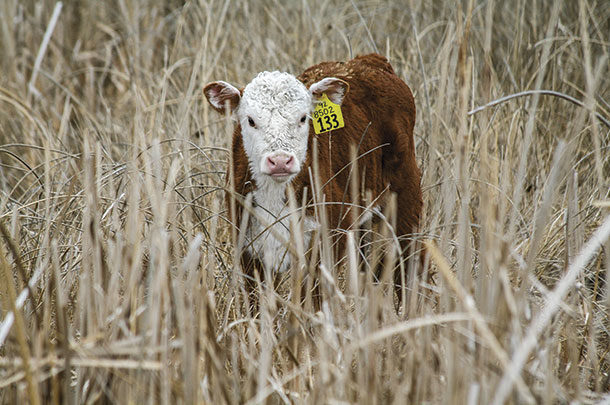Plane of nutrition affect the cow and the unborn calf she is carrying – and that impact begins almost immediately. Planning for a healthy calf begins prior to the breeding season and continues throughout the pregnancy.
You’re creating the foundational building blocks of that fetus from muscle development and fat development to gut development and ovary development – all of that is taking place. All those organs, three weeks post-conception, we’re having differentiation of these cell types.
But all those crucial biological systems develop along different timelines, which a producer can affect by how much nutrition the cow receives.
There are certain organs in the fetus that are always nourished, so if the cow isn’t feeling right or something is just off, the brain of the fetus is always going to get the nutrients it needs. The kidneys are fed, too. It’s critical to make sure your cows get what they need when they need it. Development of the organ systems occurs at different rates. Improper nutrition at a certain time in gestation could impact muscle development but not cardiac function – it all depends on the stage of each organ’s developmental state.
Getting the most from a calf starts with the nutrients his mother receives during pregnancy. It’s when the next generation starts feeding, so producers should target when they can have the greatest effect on that soon-to-be-born calf.
This is particularly important in mid to late pregnancy, and if I had to narrow it down, the last trimester is a true targeted time frame for high-quality nutrition.
Consider some biological systems programmed during pregnancy and how they affect what a producer can expect to get from the resulting calf.
1. Nutrient restriction: Early can help, but late causes harm
During early to midgestation, nutrient restriction appears to increase the efficiency of how the placenta feeds the fetus in both Angus and Brahman heifers. However, late pregnancy nutrient restriction has been associated with decreased birthweight, increased mortality and slowed postnatal growth of surviving offspring.
If you restrict the dam, sometimes there are placental compensations that happen, but in those animals that are nutrient restricted to the point they have reduced birthweight, you already limited the trajectory of growth.
2. A third of a calf’s life is supported by the placenta
Depending on your livestock system and the species you’re studying, that animal is going to spend 25% to 50% of its lifetime being nursed by the placenta when you consider conception to consumption. Life in the uterus, and the ability to transport nutrients across the placenta, are hugely important and predetermine a calf’s growth potential after birth.
3. Metabolism is programmed in the uterus
One of the reasons growth could be altered after birth is that metabolism can be programmed. When a fetus is not getting enough of a nutrient in utero, the gastrointestinal tract may alter its ability to absorb nutrients. Lifelong nutrient and eating problems can develop when the fetus is undernourished during pregnancy. This “screws up” its metabolism.
This restriction during pregnancy causes the calf’s growth to become skewed “downstream.” The calf of a cow with restricted nutrition during gestation just never has the growth potential of its counterpart out of a cow who is fed adequately during gestation. The odds of coming out and hitting the calf’s genetic potential – say you expect it to have good marbling – may not be reached because of the environment it was in during gestation.
At all times, keep in mind the calf will do everything it can to survive in the uterus. Once stressors happen to the cow – for example, she isn’t fed enough or her glucose levels are too low – the fetal liver can activate some enzymes it normally wouldn’t activate until later in the pregnancy, or even in neonatal life, to make sure it’s generating enough. The calf is being programmed to turn on something it wasn’t supposed to turn on until later down the road.
I urge producers to think of fetal programming and supplying the cow herd with nutrients like this: If you’re rolling a ball down a hill and then divert the ball to go along another path, you’ll never get it back to where it needed to go in the first place. We know genetics are really important, but if you put those genetics in the wrong environment, even if it’s the wrong environment in utero, you’re not going to reach the genetic potential you think you should because you sent it down the wrong path.
It is also critical for producers to work closely with a veterinarian to make sure they are giving the appropriate vaccinations to protect the cow and her unborn calf from disease challenges. Any disease challenge to the cow diverts nutrients from the calf, and a solid vaccination program can help give the cow and calf a boost in immunity.
Every season is different. Quality of forage is different and varies. From a cost perspective, producers must avoid overfeeding or wasting feed, but sometimes there are physiological issues and too much is provided.
Our goal is to find the middle of the road place, so production efficiencies are where they need to be. ![]()
PHOTO: The physiological requirements of the young calf need to be understood so the building blocks can be set for its entire life. Staff photo.
References omitted but are available upon request. Click here to email an editor.

-
Kimberly Vonnahme
- Associate Director Outcomes Research
- Zoetis
- Email Kimberly Vonnahme







